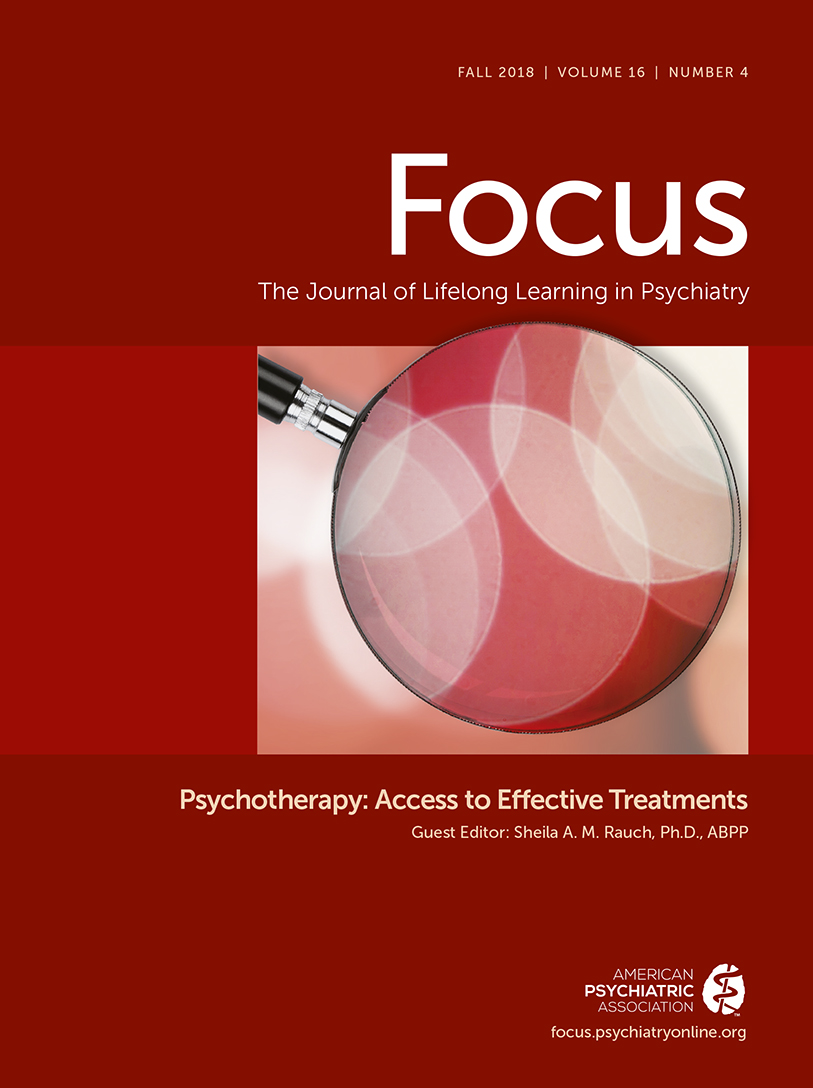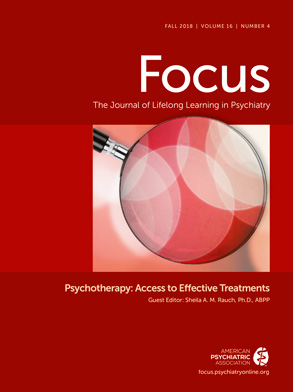Although there is a large body of evidence showing that antidepressants are effective in the treatment of depression (
1), most patients prefer psychological treatments over medication (
2). However, psychological therapies are not always available and may be too costly for many patients and for insurance systems. Furthermore, in many places in the world there are not enough trained psychotherapists available to treat all people who need treatment for depression.
Is Internet-Based Cognitive-Behavioral Therapy an Alternative to Face-to-Face Therapy?
Internet-based cognitive-behavioral therapy (CBT) may be a good alternative to face-to-face CBT in the treatment of depression, when it is delivered with some form of therapeutic guidance by secured e-mail or telephone contact. In the past two decades, a growing number of randomized trials and meta-analyses have examined the effects of Internet-based treatments of mental disorders. For example, a recent meta-analysis on the effectiveness of Internet-based treatment of depression and anxiety included 32 depression trials with more than 5,000 patients (
3). The effect of Internet-based depression CBT compared with control conditions was considerable (g=.67, CI=.51 to .81, which corresponds to a “numbers needed to treat” of three participants) and comparable to effects found for face-to-face CBT for depression.
A growing number of trials also are directly comparing guided Internet-based therapies with face-to-face therapies. A recent meta-analysis of 20 trials indicated a very small and nonsignificant differential effect size (g=.05; 95% CI=−.09 to .20), which indicates equivalent overall effects (
4). These studies were aimed at any mental health problem, however, not just depression.
Content and Delivery of Internet-Based CBT
Internet-based interventions for mental disorders can be delivered either with or without professional support. Internet-based interventions with professional support have effects comparable to those of face-to-face therapies. Those without support have smaller effect sizes than face-to-face therapies. There is a long tradition of research on guided self-help, going back to the 1960s. With this approach, the patient applies a psychological treatment to himself or herself, according to methods explained in a self-help book. Internet-based interventions can be seen as a modern version of guided self-help.
Usually, the coaches who deliver guided Internet-based interventions spend much less time delivering the intervention than do therapists in face-to-face therapy. For example, in the trials conducted by our research group, the coaches spent 1.5–2.0 hours helping a patient through a treatment (15–20 minutes for e-mail support per week for a six-session intervention) (
5,
6). This is much less than the 16 individual treatment sessions that are recommended in individual CBT for depression. In addition, the coaches who deliver treatment do not have to be trained psychotherapists or clinical psychologists. For example, the “psychological well-being practitioners” who deliver guided self-help in the Increasing Access to Psychological Therapies program in the United Kingdom have received a training of less than one year (
7).
Internet-based interventions without professional support are also effective when compared with control conditions, such as waiting list and care as usual. However, the effects are considerably smaller than those of guided interventions (
8). In a recent individual patient data (IPD) meta-analysis, Karyotaki et al. (
9) showed that the effects of unguided CBT were small but significant (effect size, g=.27). The authors also found that eight individuals with depression needed to receive unguided CBT for one individual to have a 50% reduction from his or her initial depression severity.
Unguided Internet-based CBT may be used instead of the “watchful waiting” that general practitioners often advise when patients first present with depressive symptoms. Alternatively, it may be used in low- and middle-income countries where no infrastructure for mental health care is available. Although the effects are small, the health gain can be considerable. If a large number of people are reached with unguided Internet-based CBT, the impact can be large, despite the relatively small effects on individuals. Because of their easy scalability at low costs, these interventions may still have a large potential.
Does an Internet-based treatment have to be based on CBT? CBT is a good starting point for such interventions, because it heavily relies on psychoeducation, homework, and other activities that the patient can do outside therapy sessions. However, it is not a prerequisite that these interventions are based on CBT. Some Internet-based interventions, for example, are based on interpersonal psychotherapy (
10) or psychodynamic approaches (
11).
Limits of Internet-Based CBT
It is often assumed that Internet-based CBT is only helpful for people with mild or moderate depression. However, there is actually evidence that it has comparable or maybe even larger effects for people with severe depression than for those with mild to moderate depression. This was found in an IPD meta-analysis of guided self-help interventions for depression (
12) and more recently in an IPD meta-analysis of guided Internet-based interventions for depression (
9). In our view, the severity of depression does not specifically limit the use of web-based CBT. If the intervention is adapted to the needs of the patient and the setting and if the patient can be motivated to go through the Internet-based CBT, these effects can be realized. If this is not the case, patients will drop out or not even start with treatment.
Dropout is another limitation of Internet-based CBT. In a systematic review, van Ballegooijen et al. (
13) found that the proportion of completers of individual CBT was 84%, whereas the proportion in guided Internet-based CBT was 65%, which is a considerable difference. However, Internet-based CBT was much shorter than individual CBT (five to nine sessions, versus 12–28 sessions). The two treatment formats did not differ in terms of the percentage of the intervention that patients completed (81% in Internet-based CBT and 84% in the face-to-face therapy). In unguided Internet-based CBT, adherence is much lower. Only 30% of participants have been found to complete all online sessions (
8).
Can Internet-Based CBT Be Offered to a Patient With Depression?
Yes, Internet-based CBT certainly can be offered to a patient with depression, as long as the treatment is adapted to the needs of the patient and the setting, the patient can be motivated for this type of treatment, and the patient is able to work with digital media. As with any treatment, diagnostics are very important, including suicidality, as well as monitoring progress and offering alternative treatments when Internet-based CBT does not sufficiently work. Other than those considerations, however, there is no reason not to offer these interventions to patients who have been diagnosed as having depression.

